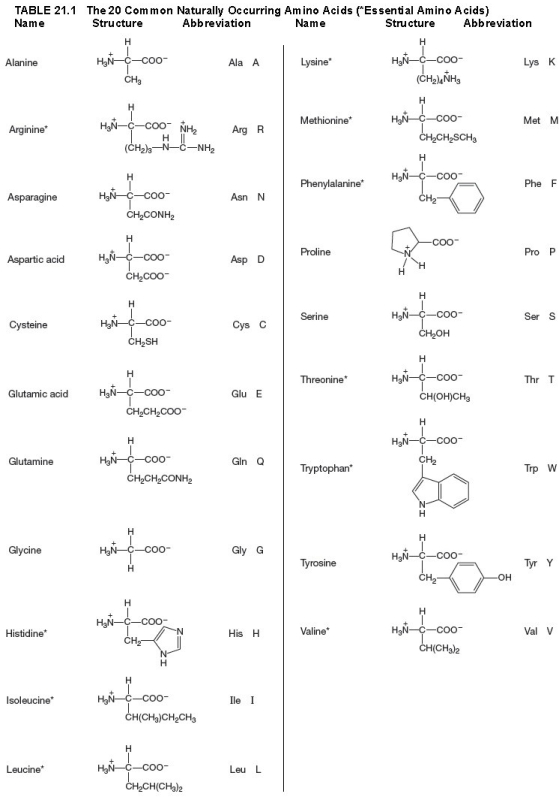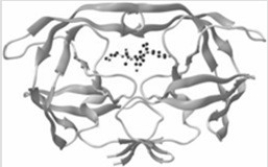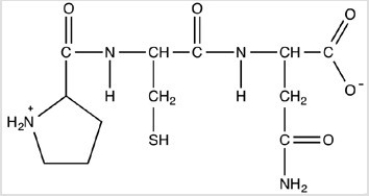A) It covalently binds to an enzyme,permanently destroying its activity.
B) It binds to the enzyme,but does not bind at the active side.
C) It binds to an enzyme but then enzyme activity is restored when the inhibitor is released.
D) It has a shape and structure similar to the substrate,so it competes with the substrate for binding to the active side.
F) C) and D)
Correct Answer

verified
Correct Answer
verified
True/False
The hydrolysis of the amide bonds in a protein forms the individual amino acids that comprise the primary structure.
B) False
Correct Answer

verified
Correct Answer
verified
True/False
HIV protease inhibitors are used to treat HIV by binding to an enzyme needed by the virus to replicate itself.
B) False
Correct Answer

verified
Correct Answer
verified
Multiple Choice
Which protein stores iron in the liver? 
A) Ferritin
B) Keratin
C) Myoglobin
D) Collagen
F) All of the above
Correct Answer

verified
Correct Answer
verified
Multiple Choice
The term protein is usually reserved for polymers of more than ________ amino acids.
A) 10
B) 40
C) 200
D) 1000
F) A) and D)
Correct Answer

verified
Correct Answer
verified
Multiple Choice
What is the name of the amino acid shown below? 
A) L-cysteine
B) D-cysteine
C) L-serine
D) D-serine
F) B) and C)
Correct Answer

verified
Correct Answer
verified
True/False
By convention,the C-terminal amino acid is always written at the right end of the peptide chain and the N-terminal amino acid at the left.
B) False
Correct Answer

verified
Correct Answer
verified
True/False
The enzyme in the ribbon diagram shown is composed primarily of β-pleated sheets. 
B) False
Correct Answer

verified
Correct Answer
verified
Multiple Choice
Which is an example of a globular protein?
A) Collagen
B) α-keratin
C) Hemoglobin
D) Amylopectin
F) B) and D)
Correct Answer

verified
Correct Answer
verified
True/False
The "cartoon" shown is an example of noncompetitive inhibition. 
B) False
Correct Answer

verified
Correct Answer
verified
Multiple Choice
What is the structure of the amino acid phenylalanine at pH 1?
A) ![]()
B) ![]()
C) ![]()
D) ![]()
F) B) and D)
Correct Answer

verified
Correct Answer
verified
Multiple Choice
Which is the simplest amino acid?
A) Serine
B) Glutamine
C) Cysteine
D) Glycine
F) A) and B)
Correct Answer

verified
Correct Answer
verified
Multiple Choice
What is the three-letter abbreviation of asparagine?
A) Asp
B) Asg
C) Asn
D) Arg
F) C) and D)
Correct Answer

verified
Correct Answer
verified
Multiple Choice
What is the strongest type of interaction between the side chains of an isoleucine amino acid and a phenylalanine amino acid in a protein?
A) Hydrogen bonding
B) London dispersion forces
C) Disulfide bond
D) Electrostatic interactions
F) A) and C)
Correct Answer

verified
Correct Answer
verified
True/False
Insulin is a small protein consisting of two polypeptide chains held together by hydrogen bonds.
B) False
Correct Answer

verified
Correct Answer
verified
True/False
When the peptide below is hydrolyzed with water,the products are the amino acids proline,cysteine,and glutamine. 
B) False
Correct Answer

verified
Correct Answer
verified
Multiple Choice
Which statement is not true?
A) A cofactor is always a metal ion needed for an enzyme-catalyzed reaction to occur.
B) The names of most enzymes end in the suffix -ase.
C) An enzyme-catalyzed reaction can be 106 to 1012 times faster than a similar uncatalyzed reaction.
D) Enzymes are proteins that serve as biological catalysts for reactions in all living organisms.
F) A) and C)
Correct Answer

verified
Correct Answer
verified
Multiple Choice
What type of intermolecular forces exist between the side chains of isoleucine and valine?
A) Electrostatic attraction
B) London dispersion forces
C) Hydrogen bond
D) Disulfide bond
F) B) and C)
Correct Answer

verified
Correct Answer
verified
Showing 81 - 98 of 98
Related Exams